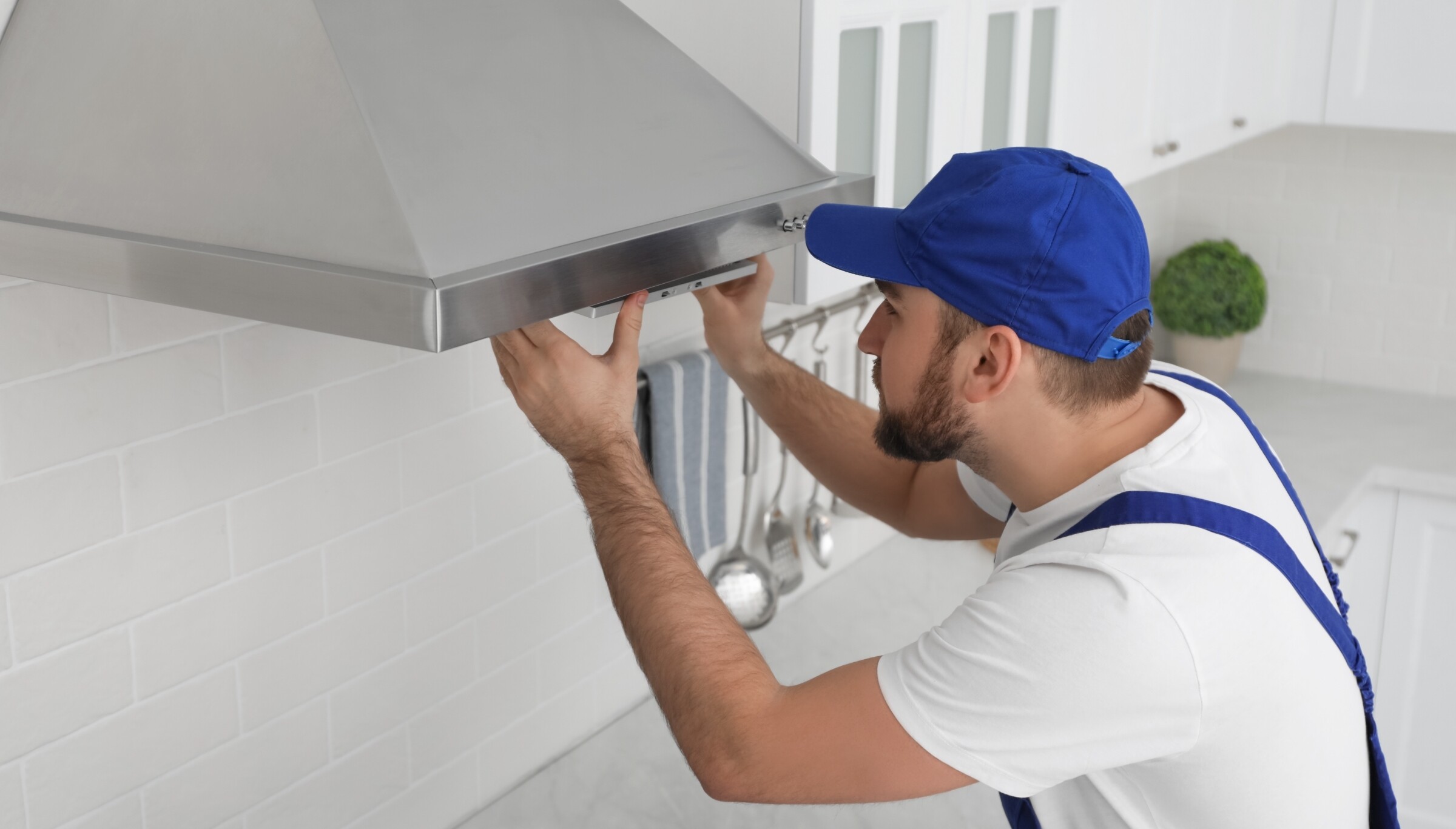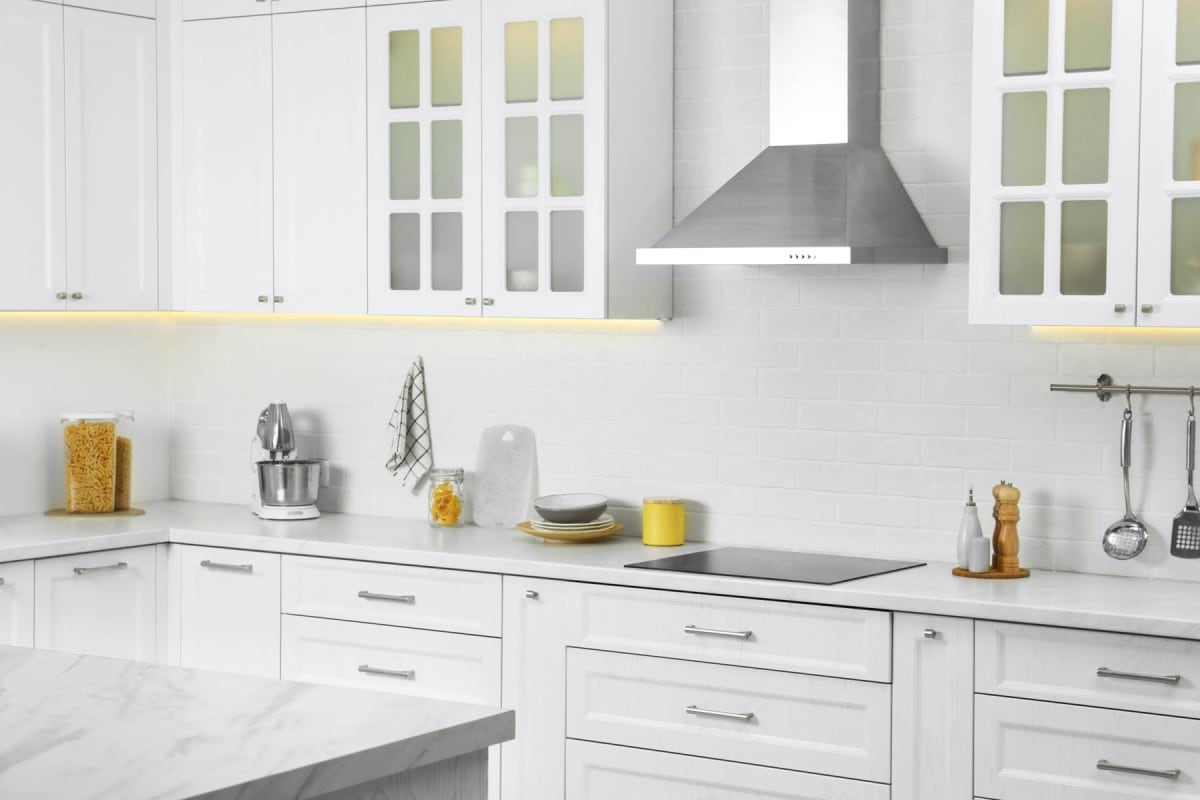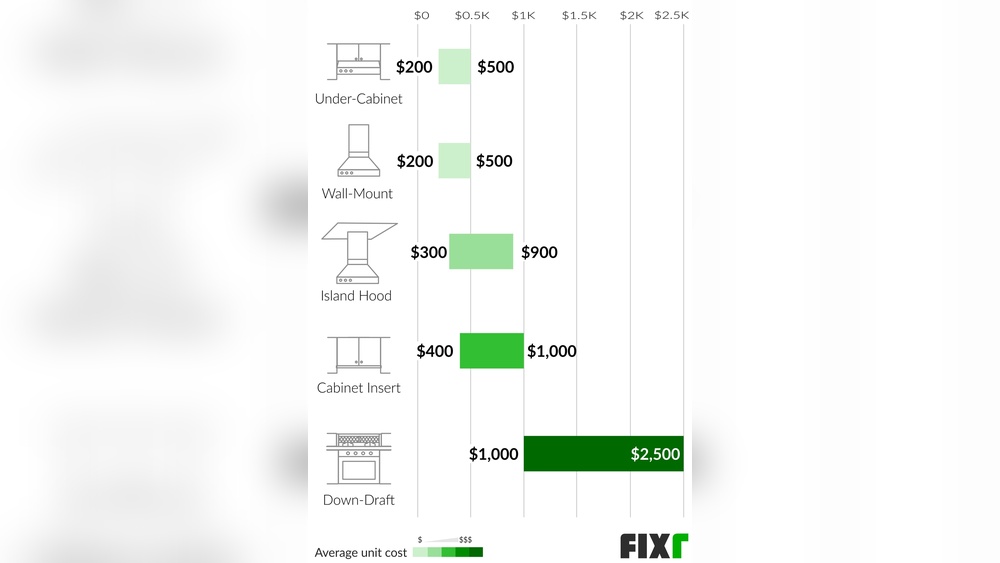Thinking about installing a kitchen exhaust fan but wondering how much it will cost? You’re not alone.
Whether you want to keep your cooking space fresh, reduce odors, or improve air quality, knowing the cost to install a kitchen exhaust fan is key before you start. This isn’t just about buying a fan—it’s about making sure your kitchen stays safe, clean, and comfortable every time you cook.
You’ll discover what factors influence the price, the types of exhaust fans available, and how to choose the right one for your needs. Keep reading to get all the details you need to make a smart, cost-effective decision for your kitchen.

Credit: www.fixr.com
Installation Costs
Installing a kitchen exhaust fan involves several costs that vary by project size and location. Understanding these costs helps plan your budget accurately. The overall expense includes both materials and labor, plus possible extra fees. Knowing each component’s cost makes the process clearer and easier to manage.
Average Price Range
The typical cost to install a kitchen exhaust fan ranges between $300 and $1,200. Basic models with simple installation fall at the lower end. More powerful or custom fans push the price toward the higher end. This range covers standard homes in most areas.
Prices depend on fan size, type, and venting complexity. For example, ducted fans that vent outside usually cost more to install than ductless types.
Labor Vs Materials
Labor usually accounts for 40% to 60% of the total installation cost. Skilled workers ensure proper fan setup and safe venting. Materials include the fan unit, ductwork, and mounting supplies. High-quality fans or custom duct runs increase material costs.
Choosing affordable materials can lower expenses, but quality should not be compromised. Proper installation prevents future problems and extra repairs.
Additional Expenses
Extra costs may arise from factors like electrical work or wall repairs. Older homes might need updates to wiring or ventilation paths. Permits and inspections can add to the final bill as well.
Unexpected issues, such as hard-to-reach areas or damage during installation, may require additional labor. Budgeting a little extra helps cover these surprises without stress.
Types Of Exhaust Fans
Choosing the right kitchen exhaust fan depends on the type of fan you select. Each type has unique features that affect performance and installation cost. Understanding these types helps make a better decision for your kitchen ventilation needs.
Ducted Fans
Ducted exhaust fans vent air outside through a duct system. They remove smoke, grease, and odors effectively. This type keeps indoor air fresh and reduces moisture buildup. Installation can be more complex and costly due to ductwork.
Ductless Fans
Ductless fans filter the air and recirculate it back into the kitchen. They use charcoal or carbon filters to reduce odors and some grease. These fans are easier to install and less expensive but less effective at removing heat and moisture.
Convertible Models
Convertible exhaust fans offer flexibility. They can work as ducted or ductless fans depending on your kitchen setup. This option allows switching modes if your ventilation needs change. Installation cost varies based on the chosen setup.
Venting Options
Choosing the right venting option for your kitchen exhaust fan is essential. It affects air quality, safety, and overall kitchen comfort. Different venting styles suit different kitchen layouts and cooking needs. Understanding each option helps you make a smart installation decision.
Venting To Outside
This method directs cooking smoke and odors outside your home. It uses ductwork that runs from the fan to an exterior wall or roof. Venting outside removes grease, steam, and harmful pollutants effectively. This option keeps indoor air clean and reduces fire risks. It usually costs more due to duct installation but offers the best performance.
Recirculating Air
Recirculating fans filter air through charcoal or grease filters. They then release cleaned air back into the kitchen. This option does not require external ductwork, making it easier to install. However, it does not remove moisture or heat from the kitchen. Filters need regular cleaning or replacement to work well. It works best in small kitchens or apartments without outside vent access.
Common Challenges
Installing kitchen exhaust fans can face several issues. Ductwork may be hard to fit in tight spaces or older homes. Long ducts reduce fan efficiency and increase installation costs. Improper venting can cause backdrafts or moisture buildup. Recirculating fans may fail to fully remove smoke and odors. Choosing the right size and placement is crucial to avoid noise and poor performance.

Credit: www.airtasker.com
Factors Affecting Cost
Several factors influence the cost of installing a kitchen exhaust fan. Understanding these can help plan your budget better. Costs vary depending on the size, fan capacity, and installation challenges. Also, professional fees play a significant role.
Kitchen Size
The size of your kitchen affects the fan size needed. Larger kitchens require bigger or multiple fans for proper ventilation. More fan power means higher costs. Small kitchens need smaller, less expensive fans. Measuring your kitchen accurately saves money.
Fan Capacity
Fan capacity is measured in cubic feet per minute (CFM). Higher CFM fans clear air faster but cost more. The type of cooking also affects capacity needs. Gas stoves need stronger fans than electric ones. Choose a fan capacity that matches your cooking habits.
Ductwork Complexity
Installing ductwork can be simple or complex. Straight duct runs cost less to install. Curved or long ducts require more materials and labor. Walls and ceilings might need cutting or rebuilding. Complex ductwork increases installation time and expenses.
Electrician Fees
Electricians charge for wiring and connecting the fan. Rates vary by location and experience. More complex electrical work raises the cost. Some installations need new circuits or breakers. Hiring a licensed electrician ensures safe and proper installation.
Energy Efficiency
Energy efficiency plays a key role in the cost to install a kitchen exhaust fan. A fan that uses less electricity saves money over time. It also reduces your home’s environmental impact. Choosing an energy-efficient model helps balance installation cost and future savings.
Impact On Utility Bills
Energy-efficient kitchen exhaust fans consume less power. This lowers your monthly utility bills. Fans with high efficiency use advanced motors and blades. They move air well without using too much energy. Over months and years, this results in noticeable savings.
Using an inefficient fan increases electricity use. It can raise your bills significantly. The cost to run the fan may outweigh its installation price. Selecting a fan with good energy performance avoids this problem.
Fan Efficiency Ratings
Look for kitchen exhaust fans rated for energy efficiency. Labels like ENERGY STAR indicate models that meet strict criteria. These fans perform well while using less electricity. Efficiency ratings show how much air the fan moves per watt used.
Higher efficiency ratings mean better performance and lower running costs. Fans with poor ratings waste energy and increase expenses. Checking these ratings helps you pick a fan that saves money over time.
Safety Considerations
Installing a kitchen exhaust fan involves important safety considerations. Proper installation helps protect your home from hazards. It also improves the air you breathe while cooking. Understanding these safety aspects can guide your choice and installation process.
Fire Hazards
Kitchen exhaust fans remove grease and smoke from cooking. Grease can build up inside ducts and catch fire. Proper venting to the outside reduces this risk. Regular cleaning and maintenance also prevent grease fires. Choosing a fan with the right power helps remove contaminants effectively. This lowers the chance of dangerous flare-ups in your kitchen.
Air Quality Benefits
Cooking releases smoke, steam, and harmful gases. Exhaust fans clear these pollutants from your home. Venting air outside stops odors and moisture from lingering. This keeps your kitchen fresh and healthy. Improved air quality reduces allergens and respiratory issues. A well-vented fan creates a safer and more comfortable cooking space.
Diy Vs Professional Installation
Deciding between DIY and professional installation for a kitchen exhaust fan affects cost, safety, and performance. Installing the fan yourself can save money but demands skill and time. Professionals ensure correct setup and compliance with local codes. Understanding the benefits and drawbacks of each option helps make the right choice.
Pros And Cons
DIY installation lowers labor costs and gives control over the project. It suits those with basic electrical and carpentry skills. Mistakes during installation can cause poor ventilation or damage. DIY may take longer and risk safety issues if done incorrectly.
Professional installation guarantees proper venting and secure mounting. Experts have experience with local regulations and tools. Hiring pros increases the total cost but reduces the chance of errors. It also provides warranties and post-installation support.
When To Hire Experts
Choose professional help if your kitchen exhaust fan needs complex wiring or ductwork. Hire experts for venting through walls or roofs to avoid leaks and damage. Call professionals if local laws require certified installers. Experts are essential when you want a reliable and safe exhaust system.

Credit: homeguide.com
Budget Tips
Installing a kitchen exhaust fan can be a smart investment, but costs can add up quickly. Budget tips help you manage expenses without sacrificing quality or performance. Smart choices in fans, installation, and upkeep will keep your kitchen safe and fresh while saving money.
Choosing The Right Fan
Select a fan that matches your kitchen size and cooking habits. Smaller kitchens need less powerful fans, which cost less. Look for energy-efficient models to reduce electricity bills. Avoid overspending on features you won’t use. A simple, reliable fan often works best.
Cost-saving Installation Tricks
Install the fan near existing vents to cut ductwork costs. Use standard duct sizes and straight runs to keep materials affordable. Schedule installation during off-peak seasons for lower labor rates. Consider doing minor prep work yourself, such as clearing the installation area. Get multiple quotes to find the best price.
Maintenance To Save Money
Clean filters and ducts regularly to keep the fan running efficiently. Replace filters on schedule to avoid strain on the motor. Check for blockages that reduce airflow and increase energy use. Proper maintenance extends the fan’s life and lowers repair costs. Set reminders to prevent neglect and costly damage.
Common Installation Mistakes
Installing a kitchen exhaust fan may seem straightforward. Yet, common mistakes can reduce its effectiveness and increase costs. Avoiding these errors ensures better air quality and safer kitchens.
Improper Venting
Venting is critical for kitchen exhaust fans. The fan must push air outside, not into the attic or crawl space. Poor venting traps smoke and grease indoors. This leads to bad smells and stains on walls and cabinets. It also creates fire risks from grease buildup in ducts. Proper venting protects your home and improves air quality.
Incorrect Fan Sizing
Choosing the right fan size is vital. A fan too small cannot remove smoke and odors effectively. A fan too large wastes energy and may cause noise problems. The fan size depends on your stove size and cooking habits. A properly sized fan works quietly and keeps your kitchen fresh. Always match the fan power to your kitchen’s needs.
Frequently Asked Questions
Do Kitchen Exhaust Fans Need To Be Vented Outside?
Yes, ducted kitchen exhaust fans must vent outside to remove smoke, grease, and odors effectively. Venting prevents poor air quality and potential fire hazards.
How Much Does It Cost For An Electrician To Install An Exhaust Fan?
An electrician typically charges $150 to $400 to install an exhaust fan. Costs vary by fan type and wiring complexity.
Do You Need An Electrician To Install A Rangehood?
Yes, hiring an electrician ensures safe and proper rangehood installation. They handle wiring and vent connections correctly.
Will Home Depot Install A Range Hood?
Yes, Home Depot offers professional installation for range hoods. They handle venting and setup to ensure proper function and safety.
Conclusion
Installing a kitchen exhaust fan improves air quality and kitchen safety. Costs vary by fan type, size, and installation complexity. Choosing a ducted fan vents smoke and grease outside effectively. Proper venting prevents odors, moisture damage, and fire risks. Budgeting wisely ensures you get the right fan for your needs.
A well-installed exhaust fan keeps your kitchen fresh and comfortable. Consider professional installation for best results and safety. Investing in a quality fan adds value to your home and cooking experience.

